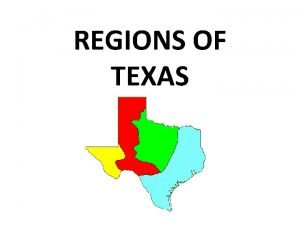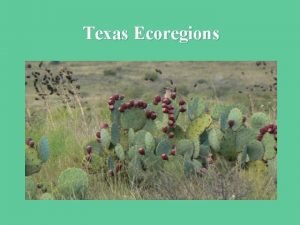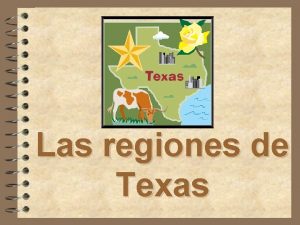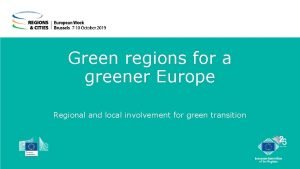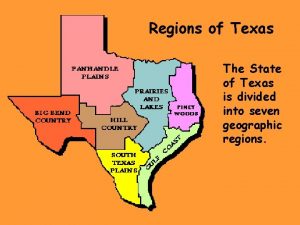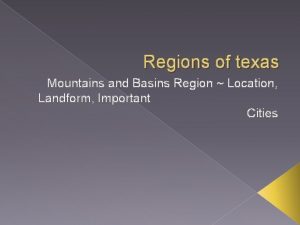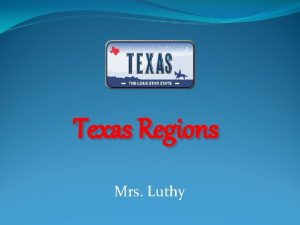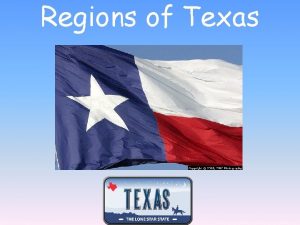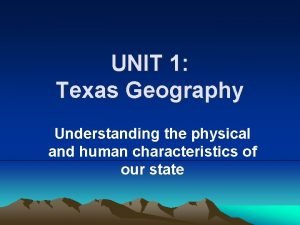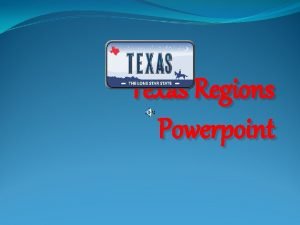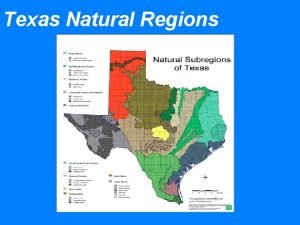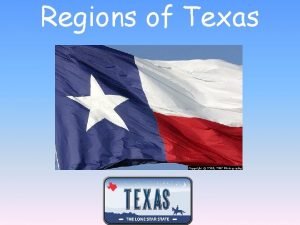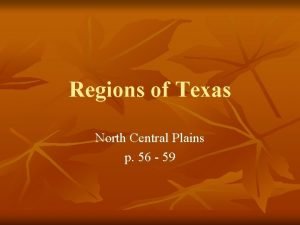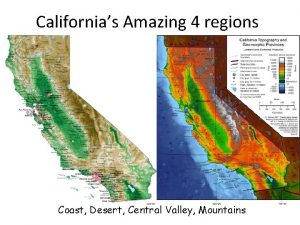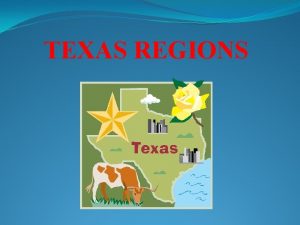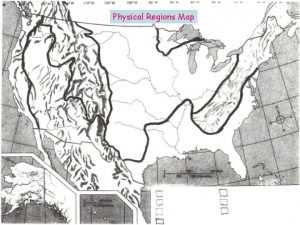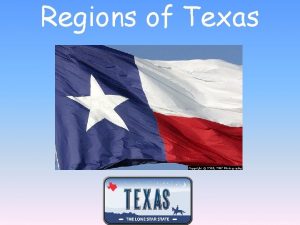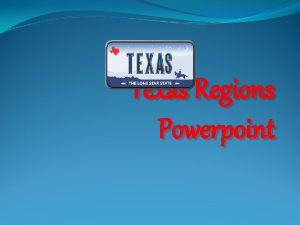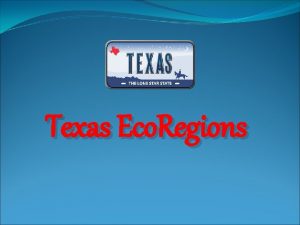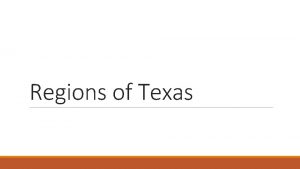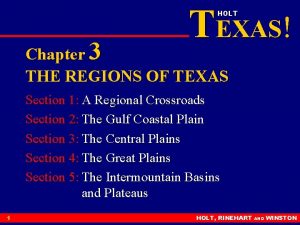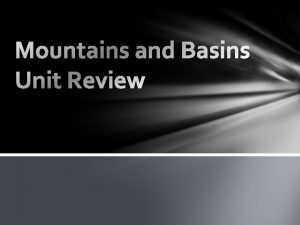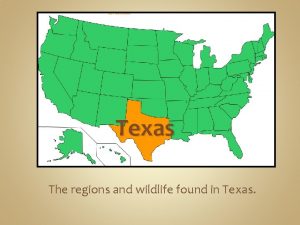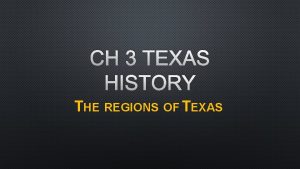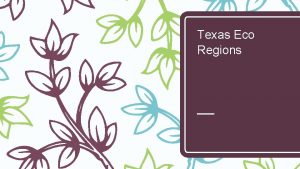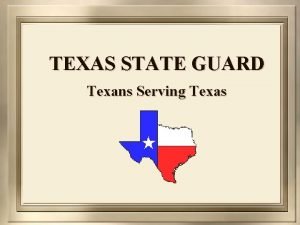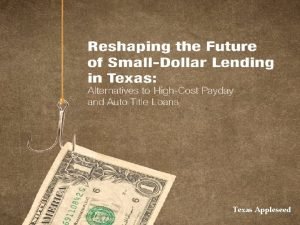The Four Regions of Texas The Four Regions

































- Slides: 33

The Four Regions of Texas

The Four Regions n Coastal Plains n North Central Plains n Great Plains n Mountains & Basins

Welcome to Texas 267, 277 square miles to be exact. v Texans living in El Paso are closer to Los Angeles, California than to fellow Texans in Texarkana. v Texarkana is closer to Chicago, Illinois than to El Paso. v Texas has deserts, swamps, plains and tropical regions. You can see mountains, deep canyons, rolling hills and seacoast. v v. You gotta love it!

The Four Regions 2. Hot summers and mild winters characterize Texas’ climate. n 3. Rainfall varies from 8” in the west to more than 50” in the east. n 4. Boerne is located in the Great Plains Region, of which the Hill Country is a part. n

The Coastal Plains 1. Largest- region in Texas 2. The population in this area is the largest of all the regions

3. The Balcones Escarpment forms the border between the Gulf Coastal Plains and the Great Plains 4. Elevation: 0 -1000 ft. n

Coastal Plains 5. Vegetation: large prairie, pine trees, post oak belt

6. Farming Economy: cattle industry, fruits and vegetables grown in this area; South Texas: The Winter Garden or The Valley Crops can be grown all year long

Coastal Plains 8. The area in that contains pine trees is called the PINEYWOODS

9. Major Cities: San Antonio, Houston, Dallas, Brownsville, Corpus Christi, Galveston, Austin, Waco

Other Information n n n Houston is the second largest sea port in the U. S. Overall the region is good for growing crops. Oil & Natural gas are found in this region Big tourist spots Most rainfall in Texas All major rivers except the Pecos & Canadian Rivers flow through this region

North Central Plains 1. Ends at the Caprock Escarpment and is in a small part of the Texas Panhandle 2. Elevation: 1000 -2200 ft. Caprock Escarpment

North Central Plains 3. Describe the land: rolling & hilly with buttes & mesas in the southern part

4. Describe the vegetation: Grassland cross timbers

5. Farming economy: Cotton and wheat

6. Major cities: San Angelo, Ft. Worth, & Abilene

Other Information n n Home to Air & Auto manufacturing Region begins in Canada and covers much of central USA

Great Plains 1. Describe the land: large stretches of flat & rolling; rises in elevation from east to west 2. The northern section of Texas is the High Plains which occupies most of the Panhandle. 3. Rivers have carved out deep canyons including Palo Duro Canyon and the Canadian Breaks. Palo Duro Canyon

Great Plains 4. Why is part of this region known as the Staked Plains? When settlers were moving in they had to use wooden stakes to mark where their land began and ended.

5. The two major land forms in this region are: Edwards Plateau and the Llano Estacado.

Great Plains 6. Economy is based on grazing cattle, sheep, & goats , as well as some farming. 7. Vegetation consists mainly of grassland. Llano Estacado

8. Major cities include: Amarillo, Lubbock, Midland/Odessa, & Boerne

Additional Information Birthplace of Lyndon Baines Johnson n Contains the Ogallala & Edwards Aquifer n Pink granite from Marble Falls was used to build the Capitol in Austin n

Mountains & Basins 1. The Mountains & Basins region is located in West Texas. 2. Describe the land : Mountains extend through much of this region with flat desert areas around it. 3. Guadalupe Peak is the highest point in Texas at 8, 751 feet. Guadalupe Peak

4. Other major mountain ranges include: Davis, Chalk, Glass & Chisos Mountains.

Chisos Mountains

Mountains and Basins 5. The major rivers that runs through this region are the Rio Grande and the Pecos. Rio Grande

6. Big Bend National Park is located in this region. Cattail Springs

7. Describe the vegetation in this region: cacti, mesquite, in higher elevations-forests

8. Major Cities: El Paso

Additional Information n Much of the economy is based on clothing manufacturing due to the cheap labor from Mexico

Additional Information § El Paso & Ciudad Juarez, Mexico (sister cities) have a combined population of 2 million people

 Coastal plains region texas
Coastal plains region texas Piney woods plants and animals
Piney woods plants and animals Regions of texas
Regions of texas Regions of texas
Regions of texas Texas regions
Texas regions Mountains and basins
Mountains and basins Landmarks in the north central plains of texas
Landmarks in the north central plains of texas How many regions are in texas?
How many regions are in texas? Regions of texas
Regions of texas Regions of texas powerpoint
Regions of texas powerpoint Texas natural regions
Texas natural regions North central plains plants and animals
North central plains plants and animals What crops are grown in the north central plains of texas
What crops are grown in the north central plains of texas Appalachian ridge and valley new jersey
Appalachian ridge and valley new jersey California desert region
California desert region Four regions of johari window
Four regions of johari window Where are the national deca headquarters located
Where are the national deca headquarters located Gấu đi như thế nào
Gấu đi như thế nào Thiếu nhi thế giới liên hoan
Thiếu nhi thế giới liên hoan Vẽ hình chiếu vuông góc của vật thể sau
Vẽ hình chiếu vuông góc của vật thể sau điện thế nghỉ
điện thế nghỉ Một số thể thơ truyền thống
Một số thể thơ truyền thống Thế nào là hệ số cao nhất
Thế nào là hệ số cao nhất Frameset trong html5
Frameset trong html5 Hệ hô hấp
Hệ hô hấp Thế nào là số nguyên tố
Thế nào là số nguyên tố đặc điểm cơ thể của người tối cổ
đặc điểm cơ thể của người tối cổ Cách giải mật thư tọa độ
Cách giải mật thư tọa độ Các châu lục và đại dương trên thế giới
Các châu lục và đại dương trên thế giới Tư thế worm breton
Tư thế worm breton ưu thế lai là gì
ưu thế lai là gì Thẻ vin
Thẻ vin Tư thế ngồi viết
Tư thế ngồi viết Cái miệng xinh xinh thế chỉ nói điều hay thôi
Cái miệng xinh xinh thế chỉ nói điều hay thôi
